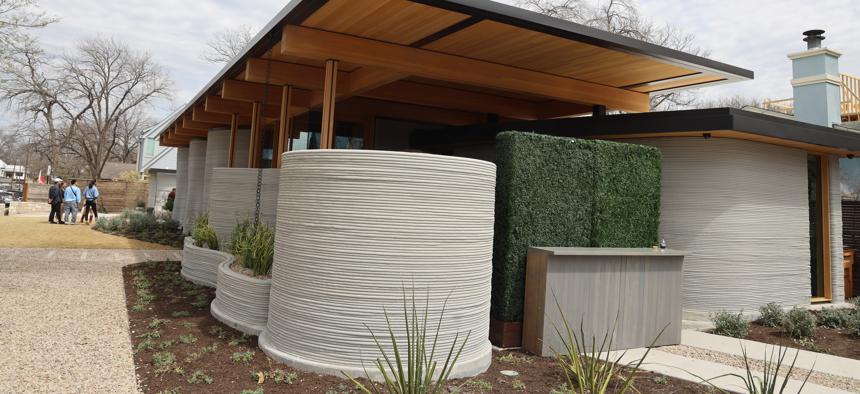Printing a place to live: In Central Texas, homes are being built with emerging 3D technology

A structurally 3D printed house is displayed at the South by Southwest SXSW Conference and Festivals in Austin, Texas, March 13, 2022. (Photo by Xu Jianmei/Xinhua via Getty Images)

Connecting state and local government leaders
3D homes can eventually help lessen the housing crisis, and do it in a climate-friendly way.
This article is republished from The Texas Tribune. Read the original article.
ROUND TOP — Layer by layer, a robotic arm lays streaks of concrete that rise to become the walls of five small vacation rentals tucked in the corner of The Halles event center in this Central Texas town.
Round Top is no stranger to short-term rentals. The town of less than 100 residents draws tourists for its antique events and live music scene and has more than 200 rentals listed on Airbnb.
But these new additions, named the Casitas at the Halles, represent what Hive3D founder and CEO Timothy Lankau hopes is a revolution in construction — 3D printed homes built mostly by machines. His Houston-based company, was launched in 2022 and has built six homes.
“There's something of a housing crisis in America, which I think is the stupidest crisis I can possibly imagine, " Lankau said. “With all of the ingenuity and resources we have, as a people, the fact that we can't figure out a better way to build walls and roofs so that everyone has a nice house seems just baffling to me.”
While the technology is new, Lankau as well as others embarking on this endeavor believe 3D homes can eventually help lessen the housing crisis, and do it in a climate-friendly way.
3D printing of residential structures is still a new concept. The first one, a 3,000-square-foot home in Yaroslavl, Russia, was completed in 2017.
A year later, an Austin-based startup called Icon showcased its first 3D-printed structure at the technology portion of South by Southwest.
“We ultimately needed to find ways to build a lot more homes a lot faster. And we landed on 3D printing, using concrete-like material,” said Tom vonReichbauer, the CFO of Icon, which is building an entire subdivision near Austin using 3D printing technology. “Advanced robotic construction is the most promising path forward.”
A small 3D-printed home’s walls can be built in under 24 hours, with printing on larger single-family homes' walls ranging from 10 to 45 days.
The average single-family home using traditional methods takes six to eight months to construct, according to eXp Realty.
“When you take construction, and you bring automated technologies to it and do robotic construction, you're able to help shrink the timeline it takes to build a home,” VonReichbauer said. “You're able to print [a house] with far less waste. If you've been to a traditional construction site, you've seen the amount of waste that's produced there.”
Just like with traditional construction, the foundation is laid first. After that, rebar is put in place to support the interior and exterior walls, which are printed over the rebar. The robotic arm of the 3D printing machine lays the cement like layers of frosting — leaving a hollow space for electrical wiring and plumbing that’s later filled in with more concrete. Once a wall is complete, the robot is moved to the next wall. The finished walls have a horizontal ribbed texture.
After the walls are finished, workers install doors, windows and a roof.
Both Hive3D and Icon use alternatives to portland cement — cement production is one of the biggest sources of greenhouse gases in the construction industry and is responsible for about 8% of the world's CO2 emissions per year.
Hive3D partnered with Utah-based Eco Material Technologies, which creates a range of eco-friendly alternatives to concrete called "green cement," which includes fly ash — a common byproduct from coal-fired power plants.
Unlike portland cement, their mixes don't require milling and heating limestone, which accounts for most of the product's pollutants, so it creates 92% to 99% fewer emissions, said Eco Material Technologies CEO Grant Quasha.
Quasha said the green cement doesn’t have an entirely carbon-neutral footprint because the mix requires transportation to the work site and electricity is used to run the mill to mix the materials together once it arrives, but the company claims it keeps over 6 million tons of CO2 out of the environment each year with its cement alternatives.
Icon makes its own concrete alternative called Lavacrete, which vonReichbauer says uses some portland cement. He said the company is looking for ways to make it more eco-friendly.
Built for the Climate
Walking through the first single-family home that Hive3D is building in Burton, which is about halfway between Austin and Houston, Lankau noted that the house was significantly cooler than the outside temperature on a blazing August day — even though the air conditioner had not yet been installed.
Lankau said the thick foamed concrete walls help give the homes an above-average R-value — which refers to a material’s resistance to heat transfer. Even as Texas experiences more extreme heat, the insulating properties of concrete construction should keep the homes cooler inside, which can help keep utility bills lower.
Lankau added that the concrete walls make the homes much more wind-resistant and safer during extreme weather events like hurricanes and tornados.
“We prefer to build with more curved shapes and less flat surfaces for wind to push against. The roofs are tied all the way down to the foundation and into concrete rebar,” Lankau said. “It’s a serious structure when it comes to wind.”
Concrete structures are also more likely to survive flooding without sustaining major structural damage or mold infestation, Lankau said. Traditional frame homes often require significant restoration when sheetrock, insulation and wooden framing gets inundated with water in a flood.
“When you have these foot-thick concrete walls, they are bulletproof, everything-proof. From the foundation up to the roof line, everything is inorganic, so there's nothing to rot and degrade over time,” Lankau said. “So it should, over time, not change much, this house should look the same today as it's going to look in 100 years.”
Addressing Affordability and the Shelter Crisis
About 30 miles north of Austin in Georgetown, Icon is printing an entire 100-home subdivision called Wolf Ranch in collaboration with Florida-based major developer Lennar.
VonReichbauer said the city “has been incredibly receptive to what we're doing” and the first homes sold within a few days of being listed.
Lennar is listing the homes for roughly $470,000 to $579,000; the average cost of a home in Georgetown sits at $459,932.
VonReichbauer said the company has also built 3D-printed homes in Mexico with New Story, an organization focused on aiding the shelter crisis across the globe.
In what New Story calls the world's first 3D printed community, 10 homes were built just outside of Nacajuca in the state of Tabasco for financially needy families in the region who moved into the homes in November 2021.
Icon also partnered with Austin's Mobile Loaves & Fishes to build six 400-square-foot homes in an east Austin community run by the nonprofit for chronically unhoused people.
Lankau hopes to do something similar as Hive3D expands. He believes his Round Top rentals — which range from 450-square-foot studios to 850-square-foot two-bedrooms — can serve as a model for building affordable homes in a state with a growing housing shortage.
Lankau said Hive3D will work as its own developer when necessary to make sure their homes are sold at affordable prices and wants the company to sell to a range of consumers.
“There are different bands of affordability. There's government-subsidized housing and there's housing that is just built for people on median incomes to afford. We're open to all of that,” Lankau said.
However, James Tate, an assistant architecture professor at Texas A&M University, expressed skepticism about the long-term ability of these companies to keep their prices affordable and compete in the Texas housing market.
“In this state, there is no requirement for developers to have affordable housing units, there's no incentive other than individual developers who say, ‘I believe that there should be fair housing,’” Tate said. “This state is very willing to allow housing discrimination to happen all the time.”
Tate is also skeptical that 3D printing can change the construction industry and address the housing crisis.
“As a researcher and design faculty at a university. I can't help but feel a need to be optimistic,” he said. “But I know enough about the history of architecture and construction. In every attempt that has been made to address our housing challenges, when we take a step forward another challenge arises … all property and real property is subject to forces of capitalism.”
Todd Wiseman contributed to this story.
The Texas Tribune is a member-supported, nonpartisan newsroom informing and engaging Texans on state politics and policy. Learn more at texastribune.org.

NEXT STORY: The hazards of facial recognition in schools


